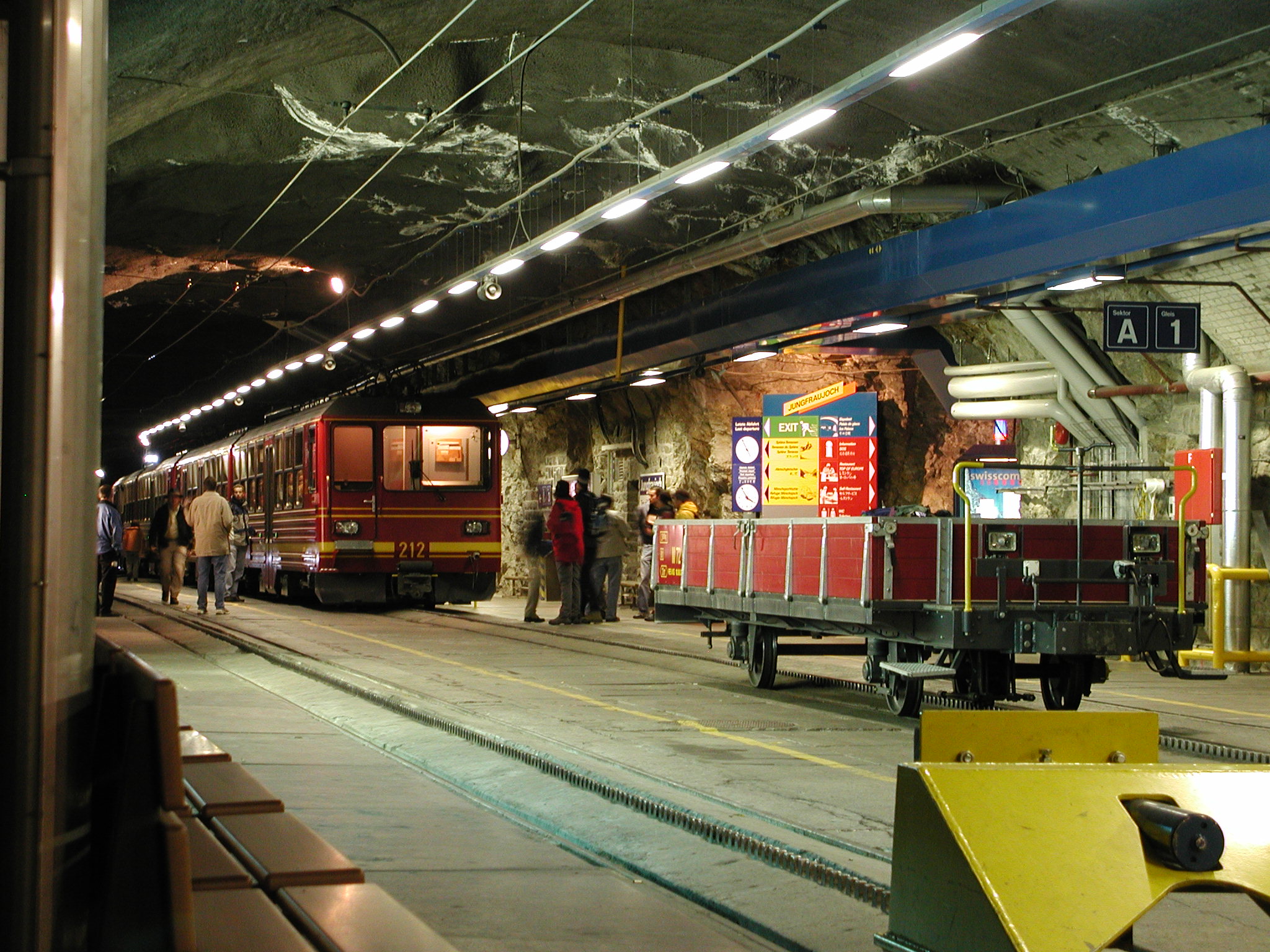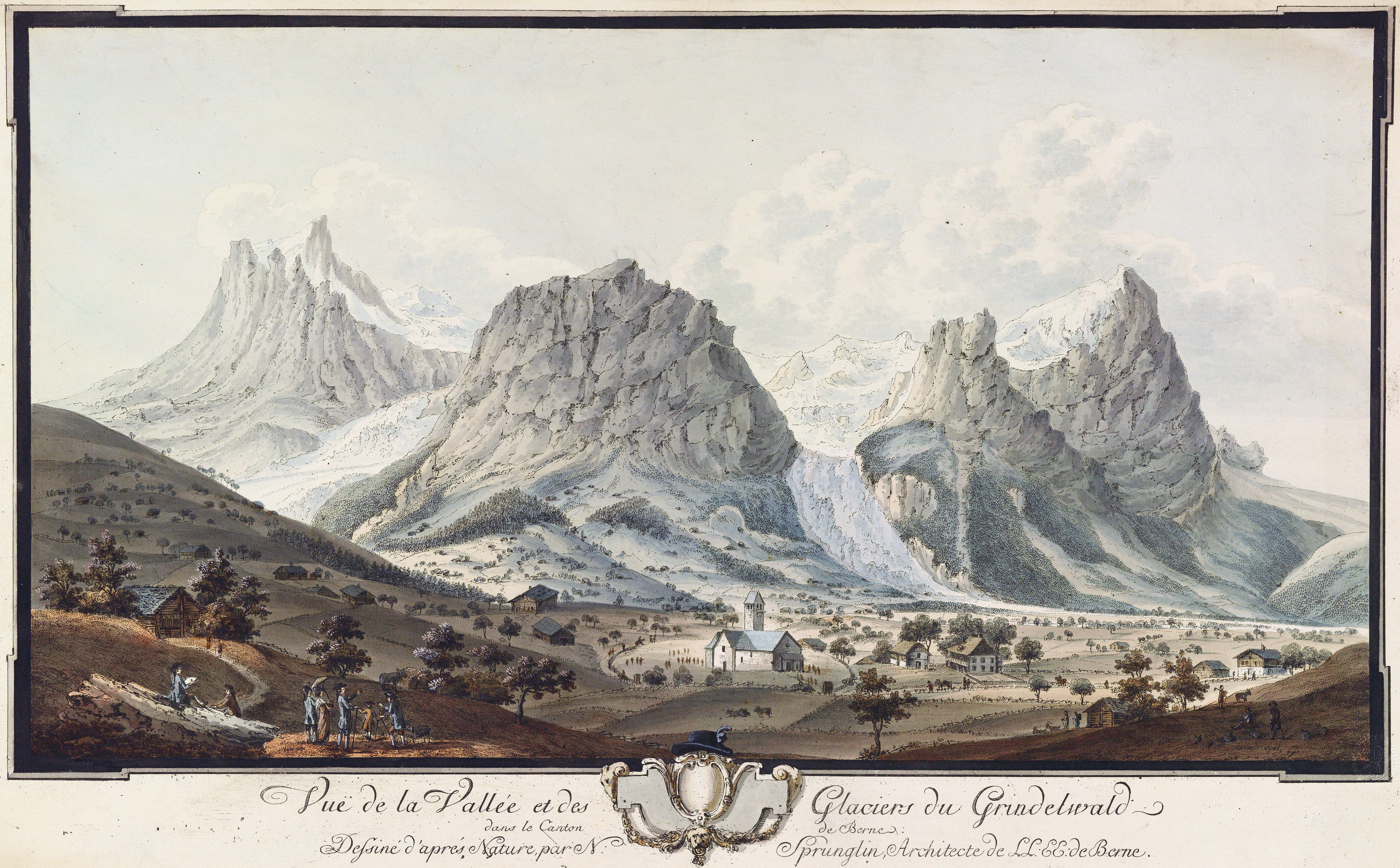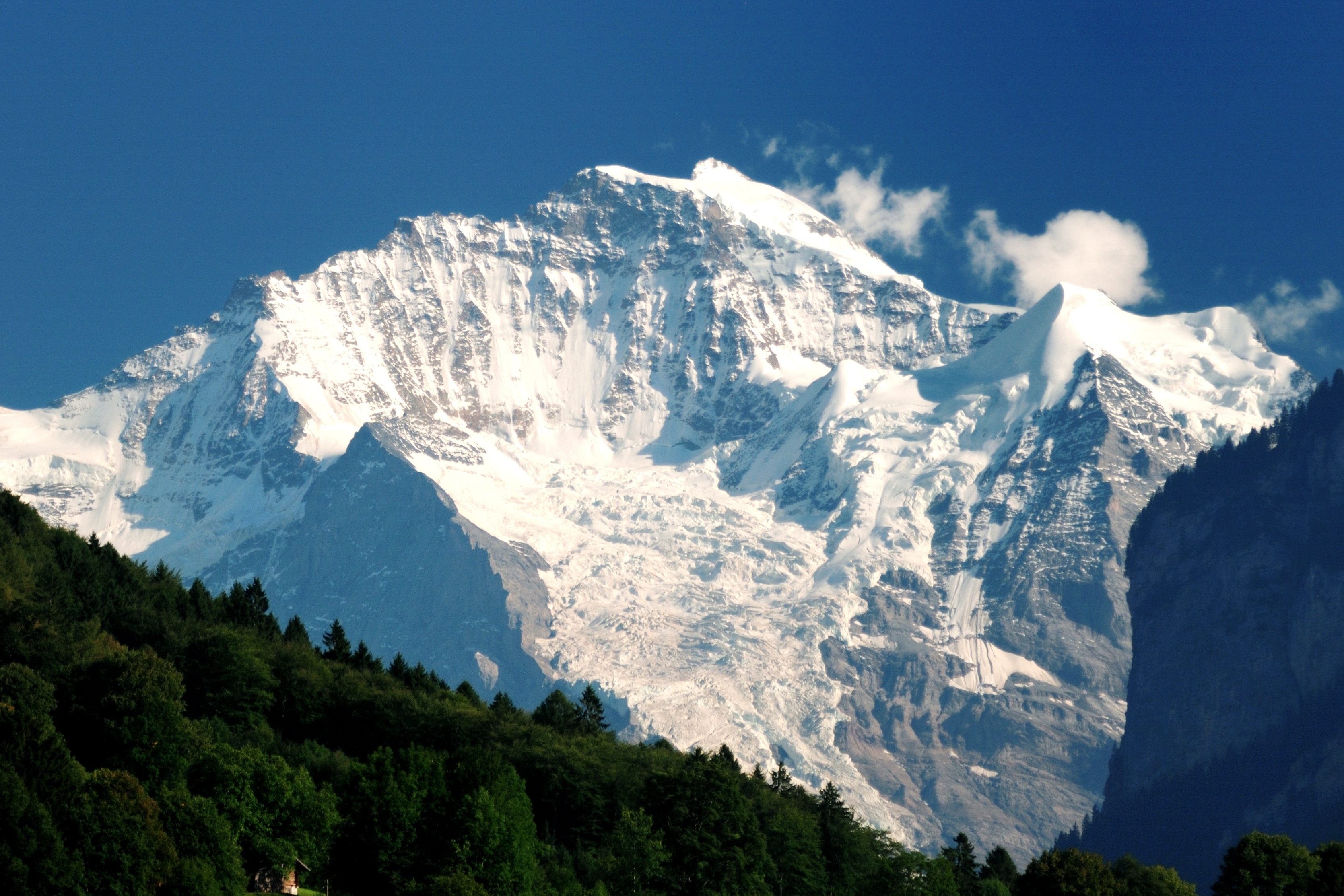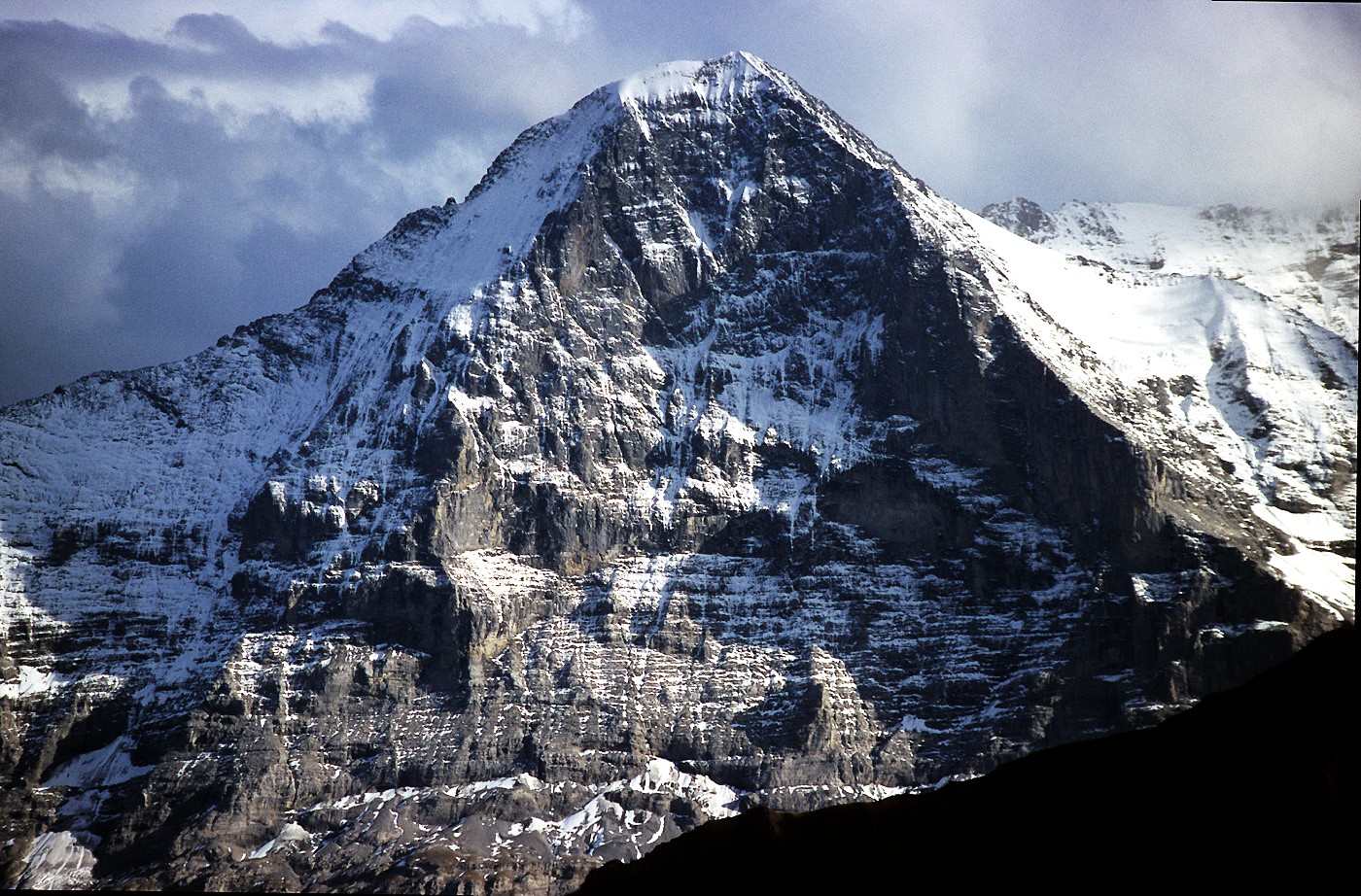|
Eiger
The Eiger () is a mountain of the Bernese Alps, overlooking Grindelwald and Lauterbrunnen in the Bernese Oberland of Switzerland, just north of the main watershed and border with Valais. It is the easternmost peak of a ridge crest that extends across the Mönch to the Jungfrau at , constituting one of the most emblematic sights of the Swiss Alps. While the northern side of the mountain rises more than 3,000 m (10,000 ft) above the two valleys of Grindelwald and Lauterbrunnen, the southern side faces the large glaciers of the Jungfrau-Aletsch area, the most glaciated region in the Alps. The most notable feature of the Eiger is its nearly north face of rock and ice, named ''Eiger-Nordwand'', ''Eigerwand'' or just ''Nordwand'', which is the biggest north face in the Alps. This substantial face towers over the resort of Kleine Scheidegg at its base, on the eponymous pass connecting the two valleys. The first ascent of the Eiger was made by Swiss guides Christian Alm ... [...More Info...] [...Related Items...] OR: [Wikipedia] [Google] [Baidu] |
Eiger Von Der Abz
The Eiger () is a mountain of the Bernese Alps, overlooking Grindelwald and Lauterbrunnen in the Bernese Oberland of Switzerland, just north of the main watershed and border with Valais. It is the easternmost peak of a ridge crest that extends across the Mönch to the Jungfrau at , constituting one of the most emblematic sights of the Swiss Alps. While the northern side of the mountain rises more than 3,000 m (10,000 ft) above the two valleys of Grindelwald and Lauterbrunnen, the southern side faces the large glaciers of the Jungfrau-Aletsch area, the most glaciated region in the Alps. The most notable feature of the Eiger is its nearly north face of rock and ice, named ''Eiger-Nordwand'', ''Eigerwand'' or just ''Nordwand'', which is the biggest north face in the Alps. This substantial face towers over the resort of Kleine Scheidegg at its base, on the eponymous pass connecting the two valleys. The first ascent of the Eiger was made by Swiss guides Christian Almer a ... [...More Info...] [...Related Items...] OR: [Wikipedia] [Google] [Baidu] |
Jungfrau Railway
The Jungfrau Railway (, , JB) is a mountain rack railway in the Bernese Alps, Switzerland, connecting Kleine Scheidegg in the Bernese Oberland to the Jungfraujoch, across the Valais border. It is the highest railway in Switzerland and Europe, running from the station of Kleine Scheidegg () to the Jungfraujoch (), well above the perennial snow line. As a consequence, the railway runs essentially within the Jungfrau Tunnel, built into the neighbouring Eiger and Mönch, to protect the line from snow and extreme weather. The Jungfrau Railway got its name from the highest of the three high peaks above it: the Jungfrau (; ), which was the initial goal of the project. A lift connecting the summit of the Jungfrau with an underground railway was planned. In 1912, the project ultimately ended at the Jungfraujoch, the saddle between the Mönch and Jungfrau. It was one of the highest railways in the world at the time of its inauguration. At Kleine Scheidegg the Jungfrau Railway connects ... [...More Info...] [...Related Items...] OR: [Wikipedia] [Google] [Baidu] |
Grindelwald
Grindelwald is a village and Municipalities of Switzerland, municipality in the Interlaken-Oberhasli (administrative district), Interlaken-Oberhasli administrative district in the Cantons of Switzerland, canton of Bern (canton), Berne. In addition to the village of Grindelwald, the municipality also includes the settlements of Alpiglen, Burglauenen, Grund, Itramen, Mühlebach, Schwendi, Tschingelberg and Wargistal. Grindelwald village is AMSL, above sea level. Mentioned for the first time in 1146, it has become an important tourist destination of both Switzerland and the Alps since the golden age of alpinism in the 19th century. It is overlooked by a section of the Bernese Alps from the Wetterhorn to the Eiger, which creates a natural barrier. Together with the adjacent valley of Lauterbrunnen, the valley of Grindelwald forms part of the Jungfrau Region of the Bernese Oberland, between Interlaken and the main crest of the Bernese Alps. Similarly to Lauterbrunnen, Grindelwald is ... [...More Info...] [...Related Items...] OR: [Wikipedia] [Google] [Baidu] |
Eigerwand Railway Station
Eigerwand is a disused underground railway station in the Grindelwald, municipality of Grindelwald in the canton of Bern, Switzerland. It is on the Jungfrau railway, which runs to the Jungfraujoch from Kleine Scheidegg. The station is located just behind the north wall of the Eiger and its principal purpose was to allow passengers to observe the view through a series of windows carved into the rock face. Trains to Jungfraujoch used to stop at the station for a few minutes for this purpose, but those descending to Kleine Scheidegg did not stop. The only access to the station other than by train is a door in the sheer face of the mountain. This has, on occasion, been used to rescue mountaineers stranded on the mountain, most famously during the 1936 Eiger north face climbing disaster. It features in this capacity in the 1975 film ''The Eiger Sanction (film), The Eiger Sanction''. It lies close to the Stollenloch, an exit and unofficial stop which is sometimes used by mountaineers t ... [...More Info...] [...Related Items...] OR: [Wikipedia] [Google] [Baidu] |
Kleine Scheidegg
The Kleine Scheidegg () is a mountain pass at an elevation of , situated below and between the Eiger and Lauberhorn peaks in the Bernese Oberland region of Switzerland. The name means "minor watershed", as it only divides the two arms of the Lütschine river, both converging at Zweilütschinen, while the nearby Grosse Scheidegg divides the Lütschine from the Rychenbach stream. The pass is traversed by a walking trail and the Wengernalp Railway, which both connect the villages of Grindelwald with Lauterbrunnen, passing through Wengen between the pass summit and Lauterbrunnen. In winter, Kleine Scheidegg is the centre of the ski area around Grindelwald and Wengen. In summer, it is a popular hiking destination, and is one of the passes crossed by the Alpine Pass Route between Sargans and Montreux. The Jungfrau Marathon, a mountain race that takes place every year in early September, ends at Kleine Scheidegg. The Kleine Scheidegg railway station is sited at the summit ... [...More Info...] [...Related Items...] OR: [Wikipedia] [Google] [Baidu] |
Jungfrau
The Jungfrau (, , , "maiden, virgin"), at is one of the main summits of the Bernese Alps, located between the northern canton of Bern and the southern canton of Valais, halfway between Interlaken and Fiesch. Together with the Eiger and Mönch, the Jungfrau forms a massive wall of mountains overlooking the Bernese Oberland and the Swiss Plateau, one of the most distinctive sights of the Swiss Alps. The summit was first reached on August 3, 1811, by the Meyer brothers of Aarau and two chamois hunters from Valais. The ascent followed a long expedition over the glaciers and high passes of the Bernese Alps. It was not until 1865 that a more direct route on the northern side was opened. The construction of the Jungfrau Railway in the early 20th century, which connects Kleine Scheidegg to the Jungfraujoch, the saddle between the Mönch and the Jungfrau, made the area one of the most-visited places in the Alps. Along with the Aletsch Glacier to the south, the Jungfrau is part of th ... [...More Info...] [...Related Items...] OR: [Wikipedia] [Google] [Baidu] |
Eismeer Railway Station
Eismeer railway station (German for ''Ice Sea'') is an underground railway station bored into the mountain Eiger on the Jungfrau Railway, which runs to the Jungfraujoch from Kleine Scheidegg. It lies at an altitude of 3,159 metres above sea level, which makes it the second highest railway station in Europe. Located just behind the south-east face of the Eiger, the station's principal purpose is to allow passengers to observe the view of the glacier Ischmeer (lit.: ''Ice Sea'', formerly called Grindelwald-Fiescher Glacier). To that end, uphill trains stop at the station for five minutes. The station opened on 25 July 1905, with the extension of the Jungfraubahn from its previous terminus at the now-closed Eigerwand station. The building of the line this far had depleted the railway company's finances, and for the next seven years, Eismeer was to remain the upper terminus. After further fund-raising and an extended construction period, the line was extended to Jungfraujoch stat ... [...More Info...] [...Related Items...] OR: [Wikipedia] [Google] [Baidu] |
Eigerjoch
The Eigerjoch is a high Alpine pass lying between the Mönch (south) and the Eiger (north). The lowest point (3,605 m) on the ridge is named ''Nördliches Eigerjoch'' while another pass (3,747 m) located closer to the Mönch is named ''Südliches Eigerjoch''. The Eiger does not lie in the ridge of the Bernese Alps which divides the basins of the Rhone and the Aar, but forms a promontory extending north-east from the Mönch, and is connected with it by a long and high arête, in which jagged teeth of rock project through a coating of ice. At the southern end, where this arete abuts against the shoulder of the Mönch, it overlooks the gently-sloping plateau which forms the summit of the Mönchsjoch, and the descent on the side of the Aletsch Glacier presents no serious difficulty. John Ball, ''The Alpine guide, Central Alps'', p. 108, 1866, London First crossing The first crossing was made by Leslie Stephen and W. and G. S. Mathews, with Ulrich Lauener of Lauterbrunnen and J. B. ... [...More Info...] [...Related Items...] OR: [Wikipedia] [Google] [Baidu] |
Jungfraujoch
The Jungfraujoch (German language, German: lit. "maiden saddle") is a Saddle (landform), saddle connecting two major Four-thousander, 4000ers of the Bernese Alps: the Jungfrau and the Mönch. It lies at an elevation of above sea level and is directly overlooked by the rocky prominence of the Sphinx Observatory, Sphinx. The Jungfraujoch is a glacier saddle, on the upper snows of the Aletsch Glacier, and part of the Jungfrau-Aletsch protected area, Jungfrau-Aletsch area, situated on the boundary between the cantons of Canton of Bern, Bern and Valais, halfway between Interlaken and Fiesch. Since 1912, the Jungfraujoch has been accessible to tourists by the Jungfrau railway, Jungfrau line, a railway from Interlaken and Kleine Scheidegg, running partly underground through a tunnel through the Eiger and Mönch. The Jungfraujoch railway station, at an elevation of is the List of highest railways in Europe, highest in Europe. It lies east of the saddle, below the Sphinx station, and is ... [...More Info...] [...Related Items...] OR: [Wikipedia] [Google] [Baidu] |
Great North Faces Of The Alps
The six great north faces of the Alps are a group of vertical faces in the Swiss, French, and Italian Alps known in mountaineering for their difficulty, danger, and great height. The "Trilogy" is the three hardest of these north faces, being the Eiger, the Grandes Jorasses, and the Matterhorn. List The six great north faces are (sorted by the date of the first ascent of the north face): * Matterhorn, first ascent in August 1931; * Cima Grande di Lavaredo, first ascent in 1933; * Petit Dru, first ascent in 1935; * Piz Badile, first ascent July 1937; * Eiger, first ascent in July 1938; * Grandes Jorasses, first ascent in August 1938. Trilogy Three of the six great north faces — the Eiger, the Matterhorn, and the Grandes Jorasses – are considered by climbers to be much harder to climb and are known as 'the Trilogy' (or the "North Face trilogy"). Milestones and records * The first climber to have ascended all six north faces was Gaston Rébuffat, a French alpinist and m ... [...More Info...] [...Related Items...] OR: [Wikipedia] [Google] [Baidu] |







